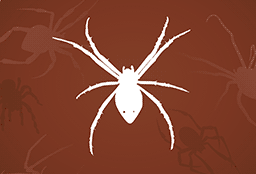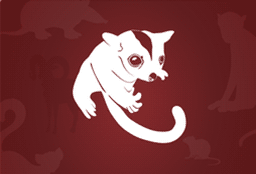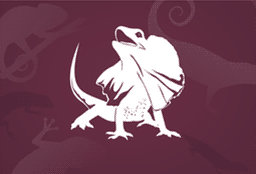An adult male has a bright orange breast and throat, with white on its lower belly and under its tail. The upperparts are dark slate grey and there is a clear white stripe on its folded wing. It has a black beak and dark brown legs. A female is mostly grey-brown with a pale buff strip on its wing. Its outermost tail feather is mostly white. A young bird looks like an adult female, but its back has buff streaks and its belly is pale with brown streaks.
Size
12 - 14 cm
The female’s abdomen can be variable but is typically brown to yellow with short silvery-white hairs. The legs are usually black with bright yellow patches on the underside of the many leg joints. Its palps (small leg-like structures on either side of its fangs) are distinctly red.
It makes golden webs, after which it is named.
Size
Females are 4 – 4.5 cm long but the tiny males are only 5 – 6 mm long (body length). The Females can have a legspan of up to 15 cm!
The adult male has a bright-yellow underbody, olive-green back and wings, and a black head with a bright-yellow collar. Its throat is white, with a broad black band which separates it from the yellow breast. Its beak and legs are black. The adult female has grey upperparts with a pale olive tinge, and is pale grey below with a pale yellowish tinge. Its beak is dark brown and its legs are grey-brown. Both sexes have a red-brown eye. Juvenile birds are rufous above and below, and as they mature, gradually resemble a female, though they retain some rufous feathers in their wings.
Its head and upperparts are mostly dark grey, with a white eyebrow and throat, a narrow grey band across the upper breast and a creamy-buff belly. The feathers of its long tail have white edges and tips, and the tail is often fanned out.
Size
14 – 16 cm long
Large to small tree or shrub up to 25 m high (commonly around 5 m), branches, flower heads and lower surface of leaves greyish or silvery
Pneumatophores (erect, pencil-like aerial roots specialised for gaseous exchange) are numerous and project from shallow lateral roots.
Leaves
Leathery and measure up to 16 cm in length and 5 cm in width. They are ovate, pointed and arranged opposite one another on the stems. The leaves are glossy green above with a distinctive pale and slightly hairy, grey underside. Stomata (pores) and salt glands are scattered over the entire leaf surface but are more abundant on the underside. Leaves are often covered in crusted salt from the exuded secretions.
Flowers
Yellow-orange or golden. Flower clusters dense, arranged at leafy shoot tips; flower stalks 10 – 30 mm long. Flower 4 - 8 mm long with a corolla of four fused pointed petals 3 - 7 mm wide.
Dark grey to brown body, with lighter grey fur on its head and golden-orange fur encircling its neck. Its wings are black.
Distinctive feature
Fur on its legs that extends to its ankles.
Size
23 cm to 29 cm head and body length); wingspan over 1 m.
Found in two broad forms. The main form is dark grey to dull blueish-black with numerous, scattered, cream-colored spots. The snout is marked with prominent black and yellow bands extending under the chin and neck. The tail has narrow black and cream bands which are narrow and get wider towards the end of the tail.
The other type, known as Bells form, is typically found in dryer parts of NSW and Queensland. It has broad, black and yellow bands across the body and tail. Close up, these bands are made up of various spotted patterns.
Also known as the Tree Goanna.
Size
About 55cm long (head and body); 140 cm long (head to tail). Some may grow up to 2.1 m long (head to tail).
Predominantly pale tawny-orange with a heavy black border that encloses large white spots in the forewing. The inner leading edge of the forewing is deep red-brown. The underside is similar to the upper side but paler with narrower black margins. Males have a distinct patch of dark grey sex-scales on the upper side of the hindwing.
The caterpillars have three pairs of tentacles and yellow, white and black rings.
Size
7 - 8 cm wingspan.
The caterpillar (larva) is green with a hump on its upper back and small white dots over its body. The butterfly (adult) has brown or black outer wings with some white markings plus two green blotches, and green inner wings (closest to its body). The underside of each wing has the same patterning but the green parts tend to be darker. It has “tails” at the tip of each hindwing.
There are two recognised subspecies Graphium macleayanus macleayanus from Queensland and NSW, and Graphium macleayanus moggana from Tasmania, Victoria and parts of subalpine NSW.
Size
Caterpillar 4 cm long; Butterfly wingspan 5 – 6 cm (can reach up to 8 cm).
A black and white bird, the pattern varies slightly between sexes. The male has a white eyebrow above a black horizontal eye-stripe, a black face and throat, while the female has a white face and throat, with a broad vertical stripe through the eye, and no white eyebrow. Both sexes have a thin white bill and black legs and feet. Juvenile Magpie-larks have a black forehead, white eyebrow and a white throat.
The top of its head and its hindneck are black. Its forehead is covered with bright-yellow skin, which hangs down to form wattles. The rest of the head is white. Its back and wings are pale grey-brown. Below, black plumage extends from the hindneck onto the sides of its breast, and the rest of the underparts are white. Its long legs and feet are reddish and its bill is yellow. It has a prominent spur on each wing.
Juveniles are similar to adults, but have dark ‘scallop’ markings on the back and wings, and the wing spur and wattles are either smaller or absent.
Distinctive feature
A yellow wattle that extends from its forehead to behind its eye and hangs down beside its chin.
The caterpillar (larva) is initially green, white and brown and resembles bird droppings. A mature caterpillar has a dark brown head, a green body with some pale yellow and brown markings, and spines along its back.
The male butterfly (adult) is black with an arc of creamy-white spots near the tip of each forewing. Each hindwing has a creamy-white patch and a single red spot, and there are many red crescents on its underside.
The female butterfly is brown to black, and the outer half of its forewing is whitish-grey. Its hindwing has a creamy-white patch, as well as a series of blue and red crescent-shaped markings.
Size
Caterpillar up to 6 cm long; Butterflies 10 – 12 cm wingspan.
Black and white, with the pattern varying across its range. The back of its neck, upper tail and shoulders (on its wings) are white in males and grey in females, and (across most of Australia) the rest of its body is black. In south-eastern, central and south-western Australia, including Tasmania, its back and rump are entirely white. Its eye is red-brown. Young birds are usually grey rather than black and have dark eyes.
Distinctive feature
One toe faces backwards and three face forwards. It has a square-tipped tail.
A colourful bird, the upper part of its back is bright green, merging to light blue on the lower part to its rump. Its tail is black, tinged with blue, and has two long central feathers (called streamers) that extend beyond the tip of the tail. Its forehead is blue-green and the top of its head is golden. A bold black eye-stripe runs from the base of its beak and is bordered below by a narrow blue line. Its chin is yellow, changing to chestnut on its throat, below which is a broad black band. It has a green breast, becoming paler on the belly and changing to light blue from the lower belly to the vent. It has a long, slim, curved black beak and its legs and feet are grey-black.
Young birds are generally duller and greener. They lack the black band across the lower throat and the long tail streamers.
Distinctive feature
The sexes differ in the length of their tail streamers: the male has longer, more slender streamers.
The southern brown tree frog is native to southern Australia. Other common names of this tree frog are brown tree frog, whistling tree frog, or Ewing's tree frog.
Ranges from pale fawn, cream, or orange to light brown, although some individuals in western Victoria and South Australia are partly or completely green. It has a wide brown band that starts from between its eyes and runs down its back. Darker flecks are also scattered across its back. It has a narrow black or brown stripe that runs from its snout to its shoulder, and a pale stripe that runs from below its eye to the base of its arm. Its belly is white to yellow and breeding males have a light brown vocal sac (beneath their mouth).
Distinctive features
Its back is smooth with small lumps, its fingers have no webbing and its toes are half webbed.
This spider is named for the cross the female weaves into the web. There are many theories about why the female does this including, strengthening the web, for camouflage, and for increasing prey catches as the cross reflects ultra-violet light which attracts insects. It may also deter predators which must go to the effort of cleaning off the extra silk after diving into the web.
The female has a silvery head with silver, yellow, red and black bands across its abdomen, and two yellow stripes running down its underside. Its legs are dark brown to black with one or two yellowish bands. The male and juveniles are brown and cream, with brown legs. It often appears to have only four legs because it sits with its legs in pairs along the stabilimentum.
Distinctive feature
The zigzag patterns (known as the stabilimentum) it weaves into its web to form an X or a cross, after which it is named.
The striped marsh frog or brown-striped frog is a common species in urban habitats It is a mostly aquatic frog native to coastal Eastern Australia.
A pale to grey-brown back with darker brown stripes. Usually also a pale stripe running down the middle of its back. Its belly is white and often flecked with brown, and there are dark spots and stripes on its limbs.
Size
4.5 - 7.5 cm
Evergreen tree, greyish-brown bark has oak-like appearance, branchlets spreading or drooping. Can be found solo or in dense stands.
Usually 8 – 15 m high. Can reach a maximum of 20 m high (rarely) and only reaches 2 m high on clifftops. The trunk can be up to 35 cm in diameter. This tree is also found in prostrate form (lying flat on the ground), reaching 30 cm high and 2 m wide.
Leaves
Segmented branchlets with very small teeth-like leaves (0.6 - 0.9 mm long), 12 – 17 leaves arise at the nodes of segments. New growth is strongly recurved (bent or curved backwards or downwards) and become erect as they mature.
Flowers
This species is dioecious (male and female reproductive structures develop on different individuals). Male inflorescences (arrangement of flowers) are spikes, growing 1.2 – long with 7 - 10 whorls per cm (ring of floral parts borne at the same level) and a 0.8 mm long anther (pollen-bearing part of the stamen).
Metallic blue-black on top and light to dark grey on its breast and belly. Its forehead, throat and upper breast are rust in colour. It has grey legs and feet, and its eyes and bill are black. A young Welcome Swallow has shorter tail feathers than an adult and its forehead and throat are a creamy beige (instead of rust).
Distinctive feature
A deeply forked tail with a white band or row of spots on the long tail feathers.
Also known as Cape Lilac. It reaches maturity when it is 6 – 10 years old and lives for about 20 years.
Deciduous tree, usually 10 – 15 m high but can reach 45 m in its natural environment. Its canopy is 6 – 8 m wide.
Leaves
Bright glossy green and oval in shape, 2 – 7 cm long and 1 – 3 cm wide. They are arranged either side of a 12 – 45 cm long stem and turn yellow in late autumn before falling from the tree in winter.
Flowers
Pale purple to white, star-shaped, forming clusters that are 10 – 20 cm long. Each individual flower is about 2 cm in diameter and consists of 5 petals. The flowers have a chocolate scent!
A large bird of prey with a dark grey back and a white head, white chest and white belly. Their legs are also white and have long black talons. They have dark eyes and a light-coloured, hooked beak. When viewed in flight, the undersides of the wings are a distinctive half white and half grey-brown.
First-year juveniles have a buffish and ‘spiky’ head, contrasting with patchy cream and dark brown body and wings; underwing pattern also patchy, but note half-moon at base of tail feathers. Older juveniles have a pale buff-grey tail.
Their nests are massive, made of sticks and branches, usually found in a tall living tree near water or on a remote coastal cliff (on ground if on an island).
Distinctive feature
A wedge-shaped tail, distinctive when seen in flight.
The White-browed Scrubwren is a small, drab bird which inhabits the dense undergrowth in many different habitats. The male has a blackish mask; cream eye; white eyebrow and bold curving silver-white whisker-mark; rufous rump; and a variable dark tail band. The female is duller and her whisker-mark is browner.
Distinctive feature
White-brow and curving silvery whisker-mark.
A medium-sized black and white honeyeater. It has large bright yellow tail and wing panels, with a large conspicuous white cheek patch on a mainly black head. Young birds are duller with brownish plumage.
Size
16-18 cm







